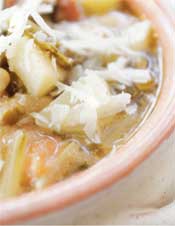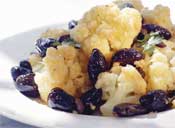Good Home Cooking - Italian Style - Minestrone Soup
There has been an exceptional range of really interesting food books published over the last six months or so, both in Ireland and abroad – and the big pile of cookbooks that built up before Christmas seems even more appealing now that there is more time to look at each one in detail and give it the attention it deserves.
With the growing interest in back-to-basics real Italian food, Lella Antinozzi’s attractive book, ‘Just Like Mama Used to Make - recipes and traditions from an Italian kitchen’ (Cassell, 192pp hardback, stg£20 in UK), should find many friends. Lella Antininozzi is an art critic and writer who now lives and works in Rome and Amsterdam,  but she was fortunate enough to grow up in a rural area in the south of Italy, near Naples, where family life revolved around the simple pleasures of a shared table, and her mother, Mamma Rosetta, is a real traditional cook of the old style – as are many of the other friends and relatives who make up the characters of this unusual book.
but she was fortunate enough to grow up in a rural area in the south of Italy, near Naples, where family life revolved around the simple pleasures of a shared table, and her mother, Mamma Rosetta, is a real traditional cook of the old style – as are many of the other friends and relatives who make up the characters of this unusual book.
Lella eases the reader into the book with introductions to the characters who peopled her world, the places where the vines, olives, tomatoes and sweet olives grew, the simple stone-built houses – each with an outside wood-fired bread oven that was lit once a week for all the baking – and the ever-busy kitchen, where Mamma Rosetta and ot hers like here were always engaged in ‘the thousand activities hiding behind a good meal’, like making home-made passata, bottling peeled plum tomatoes, prep aring home-made pasta and baking bread, pizzas and pies. Gradually the tone becomes more practical, with the introduction of the recipes which will gradually lead us on a cook’s tour through authentic local versions of many of the famous Italian dishes – and many which will be unfamiliar too.
Minestrone
From a chapter on traditional one-dish meals, Mamma Rosetta’s version of the classic soup is essentially a summer dish, made with fresh seasonal vegetables – and, you will notice, no pasta; but this hearty soup is a perfect reviver for a chilly late winter day too, so I’m sure a little variation with the ingredients would be allowed. The cannellini beans (which are small white beans, interchangeable with haricots) make it a real meal in a soup bowl. Serves 4
1 onion, chopped
6 tbsp olive oil
2 sticks celery, chopped
2 carrots, sliced
2 red tomatoes, chopped
250ml (8fl oz) water
a piece of Parmesan or percorino cheese rind, about 2.5 x 5cm (1 x 2 in)
200g (7 oz) fresh peas, shelled
200g (7 oz) green beans, cut into short pieces
200g (7 oz Swiss chard, roughly chopped
2 potatoes, cut into fairly small pieces
stock (optional)
2 courgettes, sliced
200g(7 oz) fresh cannellini beans, already cooked
salt
chilli powder
2 cloves of garlic
5 basil leaves
4 tbsp grated Parmesan cheese
Sautee the onion in 5 tablespoons of olive oil in a large saucepan. When the onion has turned transparent, add the celery, carrots, tomatoes, water and cheese rinds, then add the peas and the green beans. After 5 minutes add the chard and potatoes, then enough hot water to half fill the pan, or stock if preferred. After another 5 minutes add the courgettes and cook for another 5 minutes. Now add the cooked cannellini beans, mix it all together and let the flavours blend for 5 minutes. Add salt to taste and a pinch of chilli powder. Use a pestle and mortar to make a pesto from the garlic, basil and grated Parmesan. When they are ground to a paste, mix them with a little olive oil and add to the minestrone. Mix well and serve. This dish is excellent served hot or cold.
 Cavolfiori con le olive - Cauliflower with Olives
Cavolfiori con le olive - Cauliflower with Olives
A brilliant way to give the humble cauliflower an instant upgrade. Serves 4:
1 medium cauliflower
60 ml (2 fl oz) extra virgin olive oil
2 cloves of garlic, crushed
chilli powder
100g (31/2 oz) black olives, stoned
Salt.
Wash the cauliflower, discard the stalk and divide it into florets. Saute it gently with the oil, garlic and a pinch of chilli powder. Cover it with a lid and cook over low heat for about 10 minutes.
When the cauliflower is nearly done, add the olives, season it with salty and continue for a few more minutes without the lid, stirring from time to time to keep it from sticking.
Ingredient of the week: Radicchio
What is it? Radicchio and cicoria are both Italian for the salad vegetable chicory, which is grown in various forms: radicchio has become family name for the lovely red-leaved varieties – especially radicchio di Verona (burgundy red) and radicchio di Treviso (streaked with white). They can be grown out of doors like lettuce or they may be forced, i.e. grown in the dark, like forced rhubarb and the well known Witloof, or Belgian chicory, which is also known as endive and has a curly version which has recently become known here simply as ‘frisee’.
Where can I get it? Many varieties are as easy to grow as lettuce, in the open ground or in containers, so that could be a satisfying project for the spring. And they are widely available in green grocers and the salad/vegetable department in the better supermarkets. You will usually find a sprinkling – especially of the red varieties – in bags of mixed salad leaves.
What can I do with it? All of the chicory family can be used in salads: they are beautiful to look at, have an interesting, robust texture, and a slight edge of bitterness, a combination that is particularly appealing in winter and marries well with strongly contrasting flavours and textures such as blue cheese, sweet, juicy pears and pecan nuts or walnuts. All can also be cooked – try, for example, a warm salad of one or more of the radicchio family, tossed with vinaigrette and balls or cubes of goat cheese, or perhaps diced bacon.





There are currently no comments
Leave a comment
Not a member? Register for your free membership now!
Or leave a comment by logging in with: